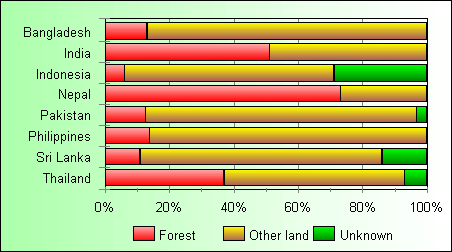

Sources of Wood Energy
The 'gap-theory', often quoted in the past and used to justify action in the field of enhancing forest resources as well as wood energy conservation programmes, was based on the belief that most, if not all, woodfuels originated from forests. The 'gap' between demand and supply was then used to calculate how long it would take before all the forests would disappear due to woodfuel use. However, 10-15 years of in-depth studies have shown that non-forest areas supply considerable amounts of woodfuels. In fact, evidence, albeit sketchy, shows that in many countries a major part, often over 50%, of woodfuels is derived from non-forest areas. The latter include village lands, agricultural land, agricultural crop plantations (rubber, coconut, etc.), homesteads, trees along roads, etc. The graph below gives an indication of the sources of woodfuels in some RWEDP member-countries.
 |
| Sources of fuelwood in various RWEDP countries |
Forest land includes forest plantations, while other land is mainly own land, neighbours land, and common land. The data are from various studies, as mentioned in the Regional Study on Wood Energy Today and Tomorrow in Asia.
Comments, questions? webmaster@rwedp.org
© FAO-RWEDP, 1999